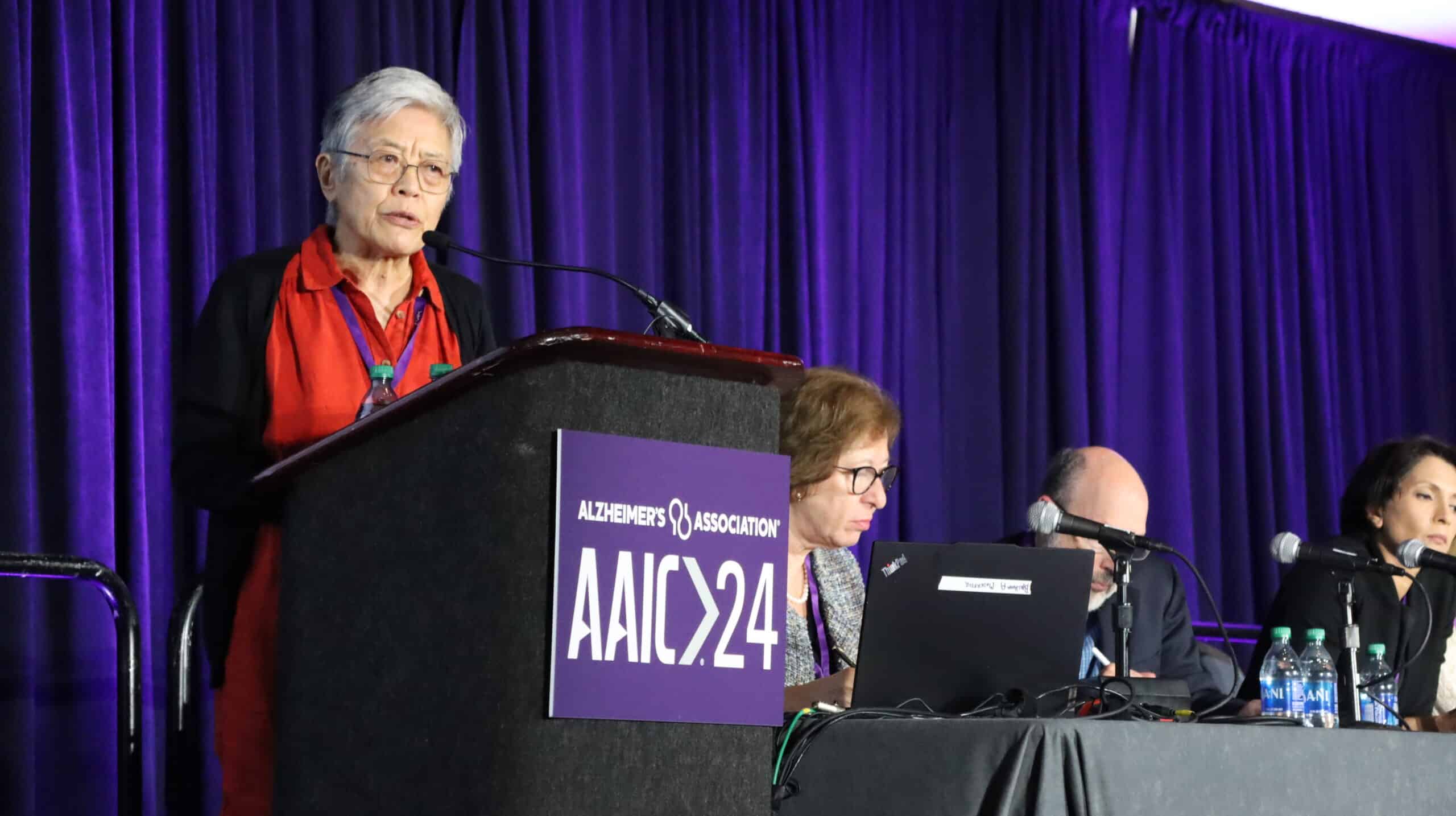By Meghan McCarthy
Author’s Note: This article is part of an ongoing coverage of the 2024 Alzheimer’s Association International Conference (AAIC). To view all highlights, please click here.
For the third consecutive year, I have had the privilege of interviewing physician-scientists and researchers to cover their work ahead of the Alzheimer’s Association International Conference (AAIC). These conversations are rich in information and inspiration for the future directions of work in Alzheimer’s disease and related dementias (ADRDs). Yet this year, with the conference being held in Philadelphia, and ongoing clinical trials to delay onset of dementia for early AD, I must admit there is a different air of excitement. Penn is a mecca of ADRD clinicians, researchers, and trainees. This was our year to not only host but highlight the tremendous contributions individuals from Penn are making in the field.
A leading force among this group is Virginia Man-Yee Lee, PhD, MSc, MBA.
As the director of the Center for Neurodegenerative Disease Research (CNDR) at the University of Pennsylvania, Dr. Lee studies the role of different misfolded proteins in various neurodegenerative disorders of aging, including Alzheimer’s disease. She has authored over 1,000 research publications and has been cited in over 200,000 articles. In recognition of her work, Research.com ranked her among the world’s top 100 scientists and as the third most prominent in 2024. She has been awarded dozens of academic honors, notably the Breakthrough Prize in Life Sciences in 2020, with a $3 million grant from a selection committee and funded by Facebook’s Mark Zuckerberg, Google’s Sergey Brin and others.
Prior to this year’s conference, I sat down with Dr. Lee to discuss her conference presentation, views about the future of our field, and to catch up. Amongst our varied conversation, her main message was clear: the future of ADRD research is tau.
Tau is a protein that has healthy functions in the brain. But, for individuals with ADRD, an overproduction of tau can lead to tangles known as neurofibrillary tangles (NFTs). These tangles cause inflammation and damage to brain cells. The term tauopathies is used to describe neurodegenerative diseases that are caused by the buildup of tau.
Dr. Lee has dedicated her career to understanding the role of tau in ADRDs.
She explained that at the beginning of her research on Alzheimer’s disease, she collaborated with Gerald Schellenberg, PhD, to identify risk genes implicated in AD. Together with Brian Kramer, a postdoc in his lab, they identified a gene that modulate tau production that when suppressed, reduced tau levels.
“We began working with c. elegans and then went on to develop animal models,” Dr. Lee said. “Now fast forward to 2023, and one of my colleagues, Xiaolu Yang, PhD, showed the same thing with a molecule known as TRIM11.”
Dr. Lee collaborated with Dr. Yang, a professor of cancer biology at the Perelman School of Medicine in a recently published study on TRIM11, where they investigated the role of this protein in tauopathy. He found that it has a significant role in protecting against tauopathies by mediating degradation of abnormal tau, removing tau deposits, and protecting against tau buildup. Dr. Yang concluded that TRIM11 suppresses tauopathy by reducing inflammation within the brain thereby improving overall cognition.
During her AAIC presentation, Dr. Lee spoke about the development of tau research in the field, beginning with her collaboration with Dr. Schellenberg and continuing with partnerships with individuals such as Dr. Yang.
Currently, drugs such as Leqembi (Lecanemab) that are in clinical trials are anti-amyloid therapeutics. This means that they are targeting beta-amyloid, the other neuropathology in AD patients. Like tau, this protein’s buildup causes damage within the brain.
In speaking with Dr. Lee, she emphasized the importance of understanding tau so that future drug development may be able to target pathological tau, in addition to beta-amyloid.
“The current treatment is to get rid of amyloid plaques,” Dr. Lee said. “However, there is really nothing right now in clinical trials that reduce tau neurofibrillary tangles. If we can understand what regulates and modulates tau, then we will be able to develop medication and therapies that could either upregulate or downregulate tau. It is generally agreed upon that tau is really the killer in ADRDs, not beta amyloid.”
A jovial storyteller, Dr. Lee noted that her 15-minute presentation didn’t allow her to delve into much beyond that. I took our additional time to chat about her overall views of the field and the conference.
As an aspiring neurologist, I find pioneers such as Dr. Lee incredibly inspiring. She paved the way for women by leading research in areas dominated by men. To follow up on previous conversations we have had about the role of women in the field, I asked Dr. Lee to reflect on the vast number of women presenting at AAIC this year.
“It is really about time,” Dr. Lee said with a smile. “I am glad that I’ve worked for so long because I am able to see what is happening, and it makes me very happy.”
At the end of our conversation, I also wanted to honor Dr. Lee’s late partner, John Trojanowski, MD, PhD, who was the director of Penn’s Institute on Aging and Alzheimer’s Disease Core Center and studied Alzheimer’s at Penn for 30 years. Given AAIC being hosted in Philadelphia, I asked Dr. Lee what John’s reaction would be to this year’s conference.
“He would be so excited,” Dr. Lee stated after a short pause. “He was a spokesperson for Penn and for our field of Alzheimer’s disease research. The AAIC this year, it is exploding; there are so many sessions. Over the three or four days, there are six parallel sessions. This is something I have never seen before.”


